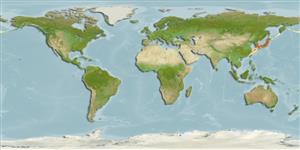Actinopterygii (ray-finned fishes) >
Scorpaeniformes (Scorpionfishes and flatheads) >
Sebastidae (Rockfishes, rockcods and thornyheads) > Sebastinae
Etymology: Sebastes: Greek, sebastes = august, venerable (Ref. 45335). More on author: Hilgendorf.
Environment / Climate / Range
Ecology
Marine; demersal; depth range 3 - 100 m (Ref. 58496). Temperate, preferred ?
Northwest Pacific: Japan, the Korean Peninsula and China.
Length at first maturity / Size / Weight / Age
Maturity: Lm ?, range 26 - 28 cm
Max length : 65.0 cm TL male/unsexed; (Ref. 56557); max. published weight: 3.1 kg (Ref. 40637); max. reported age: 20 years (Ref. 56557)
Short description
Morphology | Morphometrics
Found near shore, on rock bottoms (Ref. 11230). Juveniles associate with drifting seaweed (Ref. 12114, 12115). Ovoviviparous (Ref. 205). Commercially cultured in Japan. The species can be easily reared in aquaria (Ref. 5474).
Reported as ovoviviparous (Ref. 205).
Masuda, H., K. Amaoka, C. Araga, T. Uyeno and T. Yoshino, 1984. The fishes of the Japanese Archipelago. Vol. 1. Tokai University Press, Tokyo, Japan. 437 p. (text). (Ref. 559)
IUCN Red List Status (Ref. 115185)
CITES (Ref. 94142)
Not Evaluated
Threat to humans
Harmless
Human uses
Aquaculture: commercial; aquarium: potential
Tools
Special reports
Download XML
Internet sources
Estimates of some properties based on models
Phylogenetic diversity index (Ref.
82805): PD
50 = 0.5000 [Uniqueness, from 0.5 = low to 2.0 = high].
Bayesian length-weight: a=0.01380 (0.00894 - 0.02132), b=3.11 (2.98 - 3.24), in cm Total Length, based on LWR estimates for this species & Genus-body shape (Ref.
93245).
Trophic Level (Ref.
69278): 3.8 ±0.7 se; Based on size and trophs of closest relatives
Resilience (Ref.
69278): Very Low, minimum population doubling time more than 14 years (Preliminary K or Fecundity.).
Vulnerability (Ref.
59153): High to very high vulnerability (68 of 100) .
